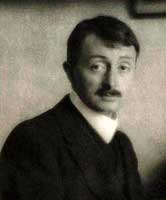
John Masefield 1913
I can’t decide whether I love or hate John Masefield‘s poem Sea Fever. I lean strongly towards love, though the poem has been repeated so many times and in so many places, that it is hard not to groan every time it is recited anew. Clichés often become clichés because they represent a fundamental truth. So it is with Sea Fever. You know the poem. The first lines are:
I must down to the seas again,
to the lonely sea and the sky,
And all I ask is a tall ship
and a star to steer her by…
I wonder what Masefield must have felt about Sea Fever. Did he have a love/hate relationship with it as well?
The poem Sea Fever is Masefield’s best known work. It is recited everywhere from elementary school class rooms to yacht club bars. It lives on all over the internet and even in our vision of space. The poem was quoted twice by James T. Kirk, Captain of the Starship Enterprise, on the television series, Star Trek, and also appears in part on the dedication plaques of the USS Enterprise-A and the USS Defiant from the same program. Sea Fever is the subject of blogs, ballads and nautical merchandise. The phrase “tall ship” also originated with Sea Fever, though not everyone got the memo.
Over his long and productive career, John Masefield wrote nineteen volumes of poetry, twenty three novels, five plays and seven works of non-fiction. He served as the Poet Laureate of England from 1930 to his death in 1967.
He wrote Sea Fever when he was only 24. It appeared in his first volume of poems, Salt Water Ballads, published in 1902. His writing career lasted 65 years. He won multiple awards and great public acclaim and yet he remains best known for a poem from his first book written in his early 20s.
The magic of the poem Sea Fever is that is captures the intense lure of the sea that so many of us know or have known. How did Masefield manage to capture in three simple stanzas a longing that seems wholly universal among those who love the sea? Perhaps not surprisingly, his writing career and his understanding of the sea began on the decks of a square-rigger.
John Masefield was the son of a solicitor. His mother died when he was six and his father died not long after. He was sent to live with his aunt and uncle. In 1891, at the age of 13, his aunt sent him off to the school ship, HMS Conway, to train for a life at sea and to break his addiction to reading, which she considered to be unhealthy.
His aunt’s plan failed miserably. On the Conway, Masefield had time for both reading and writing and fell in love with sailors’ sea stories. After graduating from the Conway, Masefield’s career at sea was short-lived. In 1894, he sailed as an apprentice on the Gilchrest, bound for Chile via Cape Horn. On his arrival, he was suffering from sun stroke and was hospitalized. He traveled home by steamer. In 1895, he again sailed on a square-rigger for New York, where he deserted, having chosen writing over seafaring as a career.
I can only wonder whether Masefield grew tired of Sea Fever after six decades of being asked to recite it, or having it brought up in conversation. Had it become an annoyance or was it an old friend?
In the next few days we will be reviewing Masefield’s second book, Sea Life In Nelson’s Time, published in 1905. It has been widely influential and is equally loved and hated by readers on both sides of the Atlantic.

for the record, i love it.
Well……..I just HAVE to love it! 🙂
~Mimi Foxmorton
Pirate Girl
As you said that this poem captures the intense lure of the sea that so many of us know or have known. Or like the writing of Joseph Conrad in its novella Youth describes this intense lure; “Between the five of us there was the strong bond of the sea, and also the fellowship of the craft, which no amount of enthusiasm for yachting, cruising, and so on can give, since one is only the amusement of life and the other is life itself”.
Thanks for this informative post about a romantic, well-loved poem and its author.
I am not surprised that “love the poem” is in the majority.
Dirk, Conrad is wonderful in capturing the both the allure and the cruelty of the sea. I love his novellas and shorts stories in particular – Youth, Typhoon, Shadow Line and my favorite with the unfortunate name, Nigger of the Narcissus.